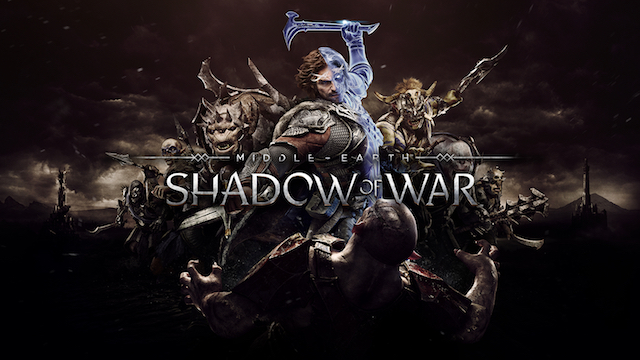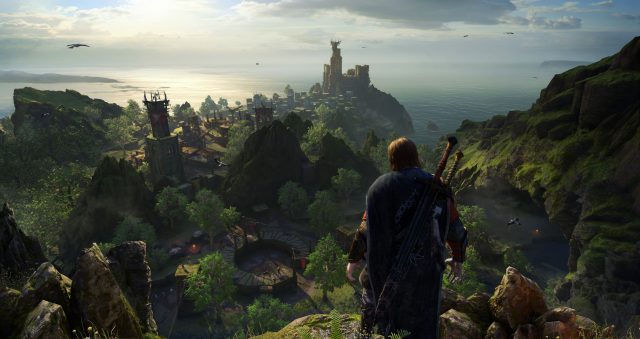
Lots has been said about the loot boxes that entice people to spend extra money, for the sake of progression, in Middle-earth: Shadow of War. The sad thing about this is that, underneath all that controversy, lays a very solid game.
Set in Mordor itself, Middle-earth: Shadow of War is the continuation of a story that was first laid out in 2014’s Middle-earth: Shadow of Mordor. Combining the iconic literary world of J.R.R. Tolkien with a new, action-packed plot, it presents a world of chaos where orc regimes thrive under different levels of leadership. The underlings listen to the captains, while those very captains listen to the warchiefs, who then listen to said region’s overlord, and together they all serve Sauron’s purpose and make up his large, overbearing army.
As Talion, an undying human whose body has become fused with the spirit of a wraith (Celebrimbor), players must navigate this world and use their unique powers to turn the tide. This is, once again, accomplished through using the game world’s intriguing Nemesis System to one’s advantage. How so? Well, the general idea is that, thanks to the angry wraith that resides inside of him, Talion has been imbued with the ability to both dominate and turn orcs, thus making them part of his own personal army. Well, that of he and the Bright Lord, who are at war with the Dark Lord, himself.
Things pick up after the conclusion of Shadow of Mordor. Although one battle was won, the war is not over, and the tide has unfortunately shifted away from the good guys’ favour. The ring that they crafted has fallen into dark hands (those of Shelob, the primordial spider, who can morph into a beautiful, raven haired woman). Of course, this won’t stand with Celebrimbor, whose ego and desires sometimes cloud his judgement and turn him into a fireball of rage, so the first order of business is an attempt to get the ring back.
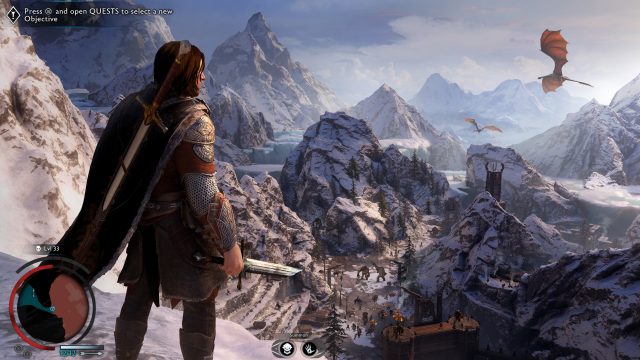
Over the course of Act One, those who return to Mordor will find themselves dealing with Shelob, while also trying to fight off an orc invasion within a major city of man. There, the player will run freely and do battle with hundreds of the ugly bastards, some of whom happen to be unique captains with their own names, strengths and weaknesses. This is where the revamped Nemesis system comes into play, as not only does killing the captains affect the world’s ecosystem, but dying at one’s hand does as well. If you perish (momentarily, at least), the orc captain who slayed you will be promoted and will then become a nemesis of yours, prompting revenge missions to appear on the map.
Revenge isn’t just a facet of this first part of the game, as it carries throughout. Whenever you die it will have consequences, and you’ll see how the orcs reward each other for killing the ranger who threatens them and the Lord that they serve. When something kills you, it gets stronger and nastier, and may also celebrate by holding a feast. What results is a more dangerous and challenging quest, where you can choose to attempt to kill he who killed you, but will have to face more ordeals in order to do so. Ordeals that take the form of other captains and larger arenas, which are, of course, filled with more underlings than ever before.
Whenever a captain comes into play, its presence is announced. You’ll be hacking and slashing away at grunts, and then all of a sudden the perspective will change and the camera will centre itself on an even uglier adversary, whose vocal chords taunt you and whose weapons wish to spill your man blood. These are very wordy creatures, whose words sometimes clash with their exteriors, which make them look like brainless idiots. At times, this chatter can also be annoying, as it can go on and on and on. However, there are occasions where it really stands out, such as when a really interesting orc with a unique personality trait comes into the fray. Two that stood out most happened to be a singer, who sang a comical song about how he was going to murder me, and a creepy creature who kept calling me pretty.
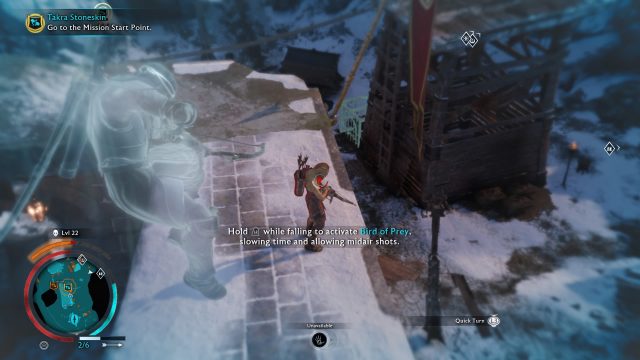
Like before, each of these captains (and the warchiefs, whose numbers are less) come bearing different names and levels. This means that, as Talion levels up and ventures to new parts of Mordor, he will continue to come across more powerful adversaries, all of whom are out for his blood. The tides of these battles can quickly change, though, especially if Talion turns nearby orcs then tasks them with fighting for him. To do this, he’ll have to fight, because captains must be broken in battle before they’ll become susceptible to having their minds spiritually adjusted. The regular nobody orcs don’t need such foreplay, but it is best to turn them while in stealth, because any type of hit, be it from a sword or an arrow, will stop your meter and force you to try again.
The same is unfortunately true for healing. You see, in order to actually heal oneself, the player must press the circle button to begin sucking the life out of a nearby enemy. This is easily done when there are only one or two around, especially if they don’t notice your existence, but during the game’s many hectic battles it becomes nearly impossible to do. Thus, you’re stuck fighting for your life without much hope of healing during occasions where you’re greatly outnumbered, which is something that tends to happen an overwhelming amount of times during this game. Sure, you’ll sometimes get lucky and be able to heal before another enemy comes close to hitting you, but a lot of luck is required for that to happen.
One upgrade grants you the ability to quick heal, by speedily draining a nearby grunt during battle. This is accomplished by pressing two face buttons at the same time. The problem with it is that it’s not always available. Furthermore, it can also be quite finicky and sometimes fails to work.
Needless to say, this can become frustrating, because captains can hit hard and take a lot of health off in the process. The good news, though, is that Talion comes equipped with a last stand ability, which is thanks to the angry wraith that resides inside. Through it, you’re able to come back to life from a downed state, so long as you press the highlighted button when the time is right. This can happen multiple times during the same battle, but the ranger’s luck will eventually run out and leave him without a chance to get back up.
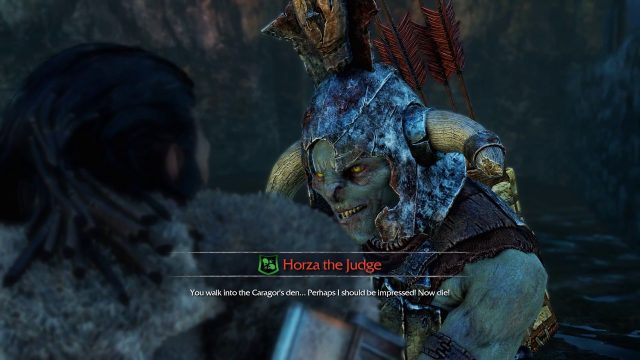
Unsurprisingly, most of the Middle-Earth: Shadow of War experience becomes focused on leveling up and altering the landscape around you, by turning orcs and making them your minions. Your end goal, then, is to create a large army that can be used to do a multitude of things, like protect Talion, issue death threats (which make other captains and warchiefs stronger, but offer you better loot in return), infiltrate the enemy by becoming bodyguards, fight in pits against other captains, or simply assassinate their peers. Most of this is handled through the Nemesis System’s menu, but there are times where you’ll have to go hands on, including whenever the opportunity to attack a fortress comes up. Doing so will help aid your cause and expand your army, and will also allow you to promote an orc to look after the new keep. It won’t be easy, though, as you’ll need to make sure to have a strong set of captains, and some purchased siege upgrades at your disposal. This is because, in order to take over a fort you’ll need to capture three or four different areas, all while doing battle against powerful enemies.
It’s this goal, and the things that lead to its success, that will make up most of the tens of hours that you’ll spend completing Middle-earth: Shadow of War. There are also quite a few story missions, many side quests (with most requiring you to do something specific in order to lure a captain out of hiding), challenges and hidden collectibles, as well. If you take your time, you could easily spend between fifty and one hundred hours roaming Mordor and doing everything it has to offer.
The story itself is pretty interesting, especially if you’re a fan of The Lord of the Rings and its iconic lore. This truly is a game that celebrates Tolkien’s fiction, even if it takes some creative luxuries with its source. The characters are interesting, as is their plight, and it’s the character study that lays at the heart of the narrative that is most intriguing. Still, the story isn’t without its faults, and can be criticized for jumping around a bit much and for also using too many visions to tell its tale.
Some of the game’s story-driven quests also tend to drag on and become repetitive. This is especially true with the ones relating to a necromancer, as they end up being the same thing over and over again, with only a change of scenery to look forward to. They can also be annoying, because you’re always tasked with draining pillars of bad voodoo energy while more and more enemies spawn around you.
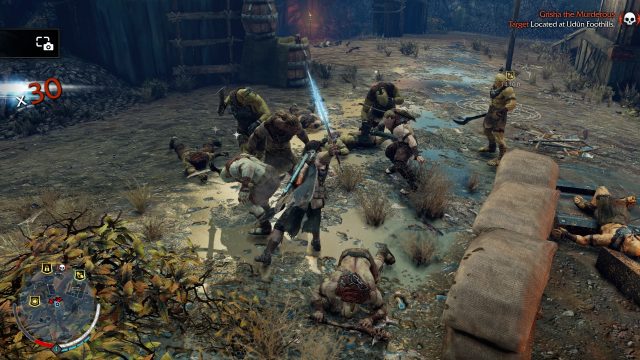
For the most part Talion is an interesting and player friendly character, who’s easy to control and has quite a few skills up his sleeve, many of which are unlocked through upgrade points. However, at its core the combat is a tad basic, consisting of a ton of repetitive hacking and slashing. This is alleviated some by the bow, which can be used to headshot foes or explode urns and fires, but you’re still looking at a lot of repeated button mashing. The crux of combat revolves around hitting an enemy when it’s vulnerable, rolling away when it’s about to hit, countering when the prompt appears or vaulting over top of it if it’s shielded. This isn’t to say that it’s not fun, for the most part, or that it’s bad. It’s just not revolutionary and can get a bit stale after a while. That is, even though Talion can earn might and then use it to pull off some cool abilities, such as one where Celebrimbor repeatedly shoots arrows.
Things are made more interesting when mounts come into play, as they can change the tide of battle in visceral ways. They’re annoying to face off against, sure, but once you’ve broken them and have hopped on their backs, they’re your new best friend. Mounts of all sizes can be ridden, so long as you unlock the applicable upgrades, and it’s all rather badass.
The main problem with Middle-earth: Shadow of War is that it’s overwhelming. You’re dropped right into the midst of chaos following a short stealth mission that opens the game. Battles can be big, and it’s not uncommon for Talion to become greatly outnumbered, even early on. However, with perseverance and smarts, players will get used to how things work and will learn how to survive, as well as how to change the momentum of each encounter.
The map is big, with several open world regions (grasslands, human constructs, wintry mountains, an open volcano and cavernous locales) which can be fast traveled to at will once unlocked, and each one has tons of icons that represent missions, challenges and collectibles. Certain towers can also be climbed (like almost every building and wall can, in Assassin’s Creed-style fashion), and then dominated, changing them from Dark to Light, and thus opening up new fast travel points. These can also be used to survey the local area, in order to find collectibles and log them on your map.

Of course, many will also cite the game’s final, optional act, as being its biggest problem. Dubbed Shadow Wars, it’s a series of ten different defensive siege missions, which provide good reason for amassing the most powerful army that you possibly can. This part of the game hides its true ending, and can be a real grind if you’re not prepared. As such, this is where the controversy comes into play, because the game’s marketplace promotes spending real world money to purchase loot boxes, which can, in turn, offer you special orcs or helpful perks. It’s a gamble, though, and one that isn’t something to take lightly as it’s a pretty scummy practice. That said, it is possible to complete Shadow Wars without spending extra cash — it just takes lots of time and effort. Also, by saving in-game currency (which you earn for completing missions and can get for dismantling weaker weapons and armor pieces that you no longer need), you’ll be in good shape to purchase very helpful upgrades. Even then, this new game mode will likely be a lengthy grind that could last tens of hours, and a difficult one at that.
Shadow Wars definitely won’t be for everyone, so it’s good that the game’s ‘main ending’ falls at the end of its third act. Its ‘true ending’ — which ties into The Lord of the Rings — is what’s actually unlocked after you complete this fourth and final chapter. Needless to say, some will find going for this worthwhile, while others won’t want to bother with the grind.
The good thing is that even if Shadow Wars turns you off, the rest of the game offers lots to like and enjoy. Its world is thriving and feels alive, with lots to see, find and do, and it’s chock full of combat opportunities that make good use of its solid, albeit unspectacular combat, which borrows from the attack and counter philosophies of Rocksteady’s Batman games. As a whole, what’s on offer is a fantastical playground that lets you live out your fantasies of being a warrior in a world full of monsters, giants and dragons, most of which are mountable. It’s not perfect, and can get repetitive, but it’s a very good game that is unfortunately being overshadowed by some executives’ decision to try to milk gamers out of extra money with awfully expensive loot boxes.
Well, gold to be exact. You’re actually paying real world money to purchase in game gold if you choose to do so. This gold, which can cost up to $130 CAD, is then used to purchase different perks and loot boxes, many of which can only be bought with it.
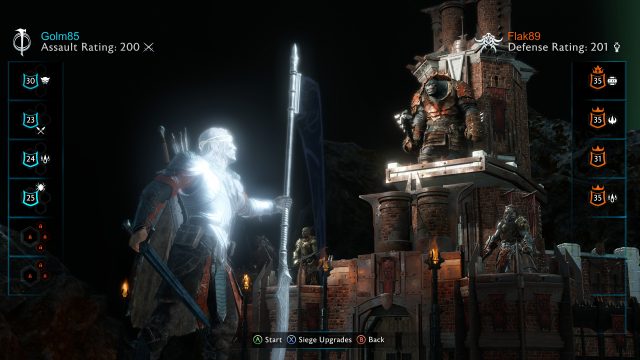
On the presentation side of things, Middle-earth: Shadow of War excels, especially on the PS4 Pro (and presumably the Xbox One X). Despite being set in a (somewhat) realistic-looking fantasy land that has a colour scheme consisting mostly of brown, black, grey and white, it’s a looker with some pretty impressive visuals. The art direction is on point, too, and some of the characters look pretty incredible, especially the Mother Nature type whose spiky green roots are a treat for the eyes. Puddles shine, explosions light the air and some impressive polish really makes things pop.
It helps, then, that the performance on PS4 (at least where the Pro is concerned) is nearly flawless. Things run like a dream, with only the odd hiccup, though this game does tend to make the console sound like a jet engine.
The audio, then, is fittingly full of clanking swords, screaming orcs and the roar of dragon fire, not to mention the explosions that result from Talion’s arrows striking explosive urns. It really brings this world to life, and is complemented by some very solid voice acting. At times, though, the music can drown out the dialogue and make it hard to hear.
In conclusion, Middle-earth: Shadow of War is a welcomed return to the world that J.R.R. Tolkien created so many years ago. Although it features some scummy practices, in the form of enticing loot crates that urge players to spend extra money, it’s saved by the fact that doing so is completely optional. Thus, a very good game is unfortunately overshadowed by something that is becoming a blight on the industry.
**This review is based on the PS4 version of the game, which we were provided with physically. We played it on a PS4 Pro.**

